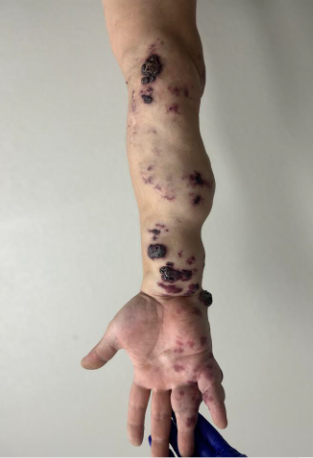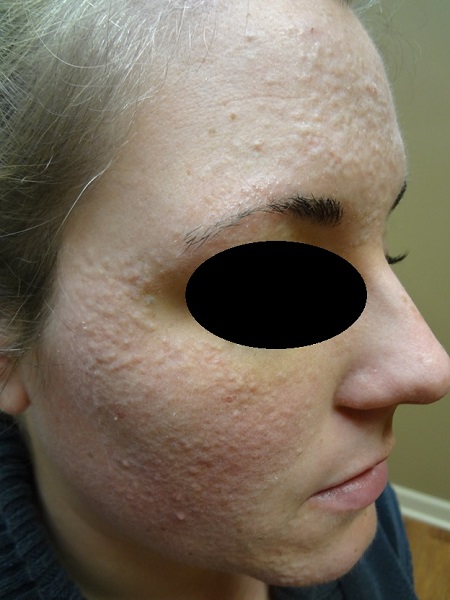CORRECT DIAGNOSIS:
Maffucci Syndrome
DISCUSSION:
Maffucci syndrome is a rare congenital disorder characterized by the presence of multiple enchondromas and vascular malformations. With fewer than 200 cases reported worldwide, this condition manifests in early childhood and typically progresses until puberty. It is notable for its equal prevalence among all ethnic groups and genders, with a median age of diagnosis around 11 years. The syndrome predominantly affects the extremities, especially the upper limbs, although it can also present with cephalic lesions that may lead to severe neuro-ophthalmologic complications.
In our patient, the presence of multiple, well-defined enchondromas—benign cartilaginous tumors arising from the medullary cavity of bones—was suspected. These tumors can lead to complications such as pain, deformity, and limited range of motion. Importantly, there is a significant risk (approximately 25%-30%) of malignant transformation of these enchondromas into osteosarcoma or other malignancies, which represents one of the most severe complications associated with the syndrome.
The underlying genetic basis of Maffucci syndrome is associated with sporadic somatic mutations in the NADP+ dependent isocitrate dehydrogenase 1 (IDH1) or IDH2 genes. These mutations play a critical role in the pathogenesis of the syndrome, distinguishing it from similar conditions. For instance, enchondromatosis can occur in two settings: Ollier’s disease, which lacks the vascular malformations seen in Maffucci syndrome.
Diagnosis is primarily based on a detailed medical history, comprehensive physical examination, and radiologic assessment. In our case, imaging studies revealed soft tissue hemangioma with calcifications, irregular skeletal expansion, thinning of the cortex, and endosteal scalloping, further supporting the diagnosis of Maffucci syndrome. Whole-body MRIs are recommended to monitor for asymptomatic chondrosarcomas, which may develop in patients with this syndrome.
Microscopically, enchondromas are characterized by “islands of intramedullary hyaline cartilage surrounded by marrow fat,” while chondrosarcomas exhibit “diffuse cartilaginous replacement (invasion) of the marrow,” leading to the complete entrapment of host lamellar bone trabeculae. Despite the utility of radiographs and MRI, both modalities have limitations in assessing low-grade cartilage lesions, with low-grade chondrosarcomas showing a significantly higher incidence of distinctive MRI findings.
TREATMENT:
A multidisciplinary approach is crucial for managing Maffucci syndrome due to its complexity and potential complications.
Sirolimus is an mTOR inhibitor with antiproliferative and immunosuppressive properties, commonly used to target vascular anomalies. It regulates vascular endothelial growth factors (VEGF) by activating hypoxia-inducible factors and downregulating the PI3K/AKT signaling pathway. Sirolimus has a relatively safe side effect profile and can lead to shrinking and softening of vascular tumors, with effective doses of 10-15 mcg/L noted within two months. Maintenance therapy at 5-6 mcg/L helps prevent recurrence. While some patients report pain improvement, changes in size and color of the tumors may be minimal. Additionally, Sirolimus has shown a reduced risk of squamous cell carcinoma (SCC) development in transplant patients, though it can cause drug-induced acne.
Ivosidenib and Enasidenib are IDH inhibitors with potential roles in treating chondrosarcomas. Ivosidenib, FDA-approved for acute myeloid leukemia and metastatic cholangiocarcinoma, showed modest results in a Phase 1 trial for advanced chondrosarcoma, stabilizing disease in 52% of participants and reducing serum 2-HG levels with minimal toxicity. Enasidenib has demonstrated efficacy in xenograft models, halving tumor growth.
In addition to pharmacological options, various treatment strategies can be employed for managing Maffucci syndrome. Surgical intervention is a key approach, as the surgical removal of large or symptomatic enchondromas can alleviate pain and improve function, particularly when tumors compromise mobility or cause significant discomfort. Laser therapy is also effective for superficial vascular lesions, offering a means to reduce the size and enhance the appearance of hemangiomas and other vascular anomalies. Furthermore, physical therapy plays a crucial role in the management plan by providing non-surgical treatment options that improve mobility and strength in affected limbs, thereby addressing functional limitations associated with skeletal abnormalities. Finally, a tailored pain management plan is essential for enhancing the patient’s comfort and daily functioning. This plan may include medications, nerve blocks, or alternative therapies such as acupuncture, ensuring a comprehensive approach to managing symptoms and improving quality of life.
For our patient, an oncologist may consider injecting the vascular lesions with sirolimus to promote shrinkage and hardening. Additionally, orthopedic surgery referral was made to assess options for surgical removal of large, painful enchondromas while addressing any skeletal abnormalities impacting our patient’s quality of life. The patient is being closely followed up due to the elevated risk of malignant transformation of enchondromas into chondrosarcomas.
CONCLUSION:
Maffucci syndrome is a complex and rare condition that poses significant challenges in diagnosis and management. Our patient’s clinical presentation exemplifies the typical features of the syndrome, emphasizing the need for thorough evaluation and a multidisciplinary approach. Close clinical follow-up is crucial for patients with Maffucci syndrome due to the risk of malignant transformation of enchondromas into chondrosarcomas, necessitating vigilant monitoring and timely intervention.
While current treatment options include sirolimus, further studies are needed to characterize its efficacy specifically in Maffucci syndrome. Additionally, the potential benefits and risks of IDH1/2 inhibitors remain unknown; however, these agents could potentially lead to a reduction in tumor growth or lower the risk of cancer progression within enchondromas. This possibility has yet to be explored, likely due to the rarity of the condition. Nevertheless, for patients experiencing severe manifestations of Maffucci syndrome or those progressing to malignancy, these agents may offer therapeutic benefits worth investigating.
Understanding the clinical features, potential complications, and the importance of coordinated care is essential for optimal patient management. Continued research into the genetic and molecular mechanisms underlying Maffucci syndrome will be crucial for developing targeted therapies and improving outcomes for affected individuals.
REFERENCES:
Bolognia, J. L., Schaffer, J. V., & Cerroni, L. (2018). Dermatology. Elsevier.
Ahrens, H. E., & Rosenberg, A. E. (2020). Maffucci syndrome: A case report and literature review. Clinical Orthopaedics and Related Research, 478(3), 636-641. [PMID: 31557122]
Choi, H., & Park, H. (2018). Maffucci syndrome: A review of the literature. The Journal of Hand Surgery, 43(8), 730-737. [PMID: 30077515]
Kim, H. J., & Kim, J. (2021). Maffucci syndrome with a focus on the IDH mutation: A review of the literature. Journal of Orthopaedic Surgery and Research, 16(1), 452. [PMID: 34712176]
Decker, J. W., & Dyer, J. M. (2019). Sirolimus in the treatment of vascular anomalies. Pediatric Blood & Cancer, 66(7), e27840. [PMID: 31010211]
Brennan, R. M., & Rock, J. (2017). Clinical implications of IDH mutations in chondrosarcoma. Current Oncology Reports, 19(8), 54. [PMID: 28639992]
Nicol, C. L., & Wellens, A. (2019). Targeted therapy for Maffucci syndrome: The role of mTOR inhibitors. Clinical Sarcoma Research, 9(1), 10. [PMID: 31486772]
Friedman, N. B., & Geller, J. (2021). Chondrosarcoma: Current treatment strategies and emerging therapies. Oncology, 35(9), 650-658. [PMID: 34452579]
Lekwuttikarn, R., Chang, J., & Teng, J. M. C. (2019). Successful treatment of spindle cell hemangiomas in a patient with Maffucci syndrome and review of literatures. Dermatology and Therapy, 32(3), e12919. https://doi.org/10.1111/dth.12919 [PMID: 30977938]
Tap, W. D., Villalobos, V. M., Cote, G. M., Burris, H., Janku, F., Mir, O., Beeram, M., Wagner, A. J., Jiang, L., Wu, B., et al. (2020). Phase I study of the mutant IDH1 inhibitor ivosidenib: Safety and clinical activity in patients with advanced chondrosarcoma. Journal of Clinical Oncology, 38, 1693–1701. https://doi.org/10.1200/JCO.19.02492
[PMID: 32024952]




